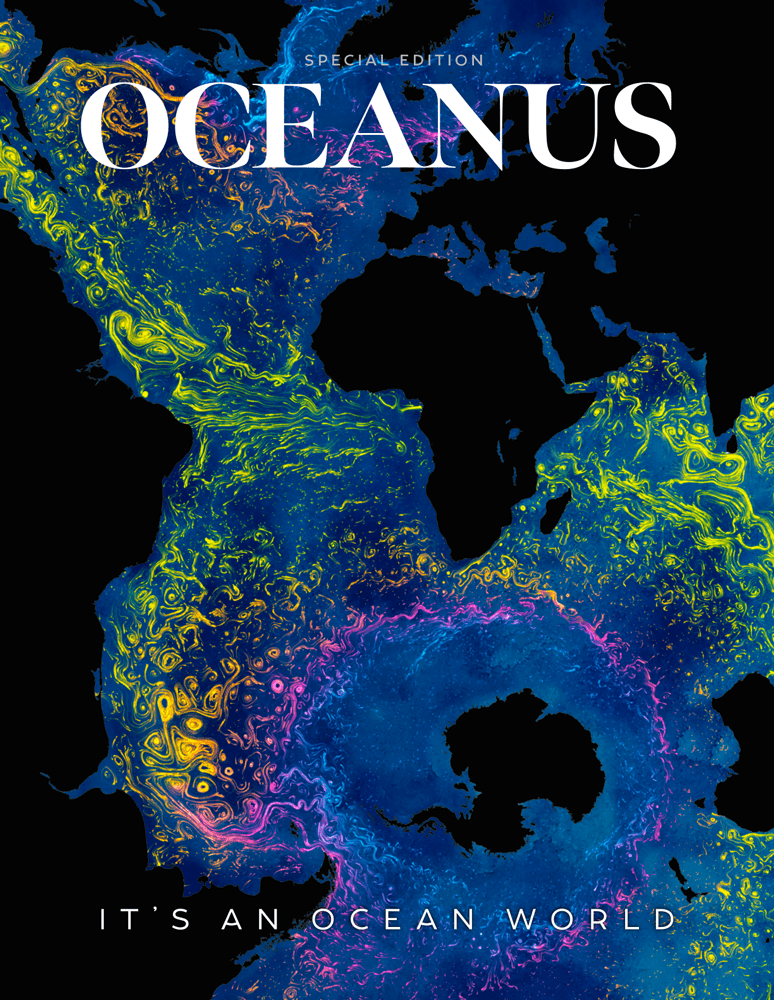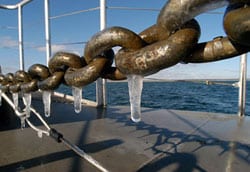
Chilly Scenes of Winter off Cape Cod
What happens in the coastal ocean when the winds blow and the waters cool?
When winter winds began rattling the storm windows last autumn, Andrey Shcherbina and Glen Gawarkiewicz shook the mothballs out of their cold-weather exposure suits and dusted off their sea boots. For the second consecutive winter, the two physical oceanographers at Woods Hole Oceanographic Institution (WHOI) and their small team braved rowdy seas to study how winter storms affect the shallow current flowing south through our coastal back yard—parallel to Cape Cod’s extended forearm, from Provincetown to Chatham.
Andrey and Glen aren’t the only ones interested in how the coastal current changes in winter. Ted Ligenza, a Chatham hook fisherman, also wants to know. The cod he chases with his longlines have an affinity for well-mixed winter water. Ted monitored the results of our experiment last winter—in particular, how offshore water temperatures changed from surface to seafloor—by watching our project’s website. Shellfish farmers and state health officials are also keenly interested, because the coastal current controls the movement of dangerous red tide algae around the Cape.
Like the atmosphere with its ever-moving high- and low-pressure systems, the oceans have the equivalent of “undersea weather.” The oceans have masses of relatively colder or saltier water that are denser and sink, or warmer or fresher waters that are more buoyant and rise. These masses continually move and interact to produce a highly energetic environment. Many factors influence the undersea weather. Cold winter air cools the sea surface; precipitation adds fresh water; tides and winds mix things up. Winter storms may do all three, but not many scientists have measured it directly because winter oceanography can be both difficult and costly, involving large ships, long cruises, and big fuel bills.
Our mission is to reveal how the Outer Cape water masses’ temperature, salinity, and currents change during the winter. Funded by the WHOI Coastal Ocean Institute and the Woods Hole Sea Grant program, we used a combination of inexpensive, lightweight moored instruments and a sophisticated autonomous swimming vehicle called the REMUS (Remote Environmental Monitoring UnitS). Both were deployed from small, fast boats—when the weather allowed.
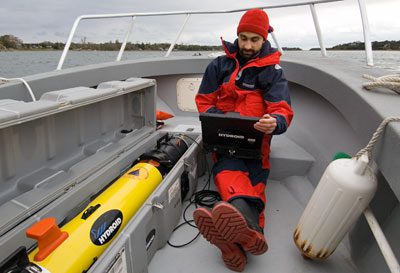
Problem is, there are no boats in the water. He arrives right on time with his smaller-than-expected skiff on a trailer. He’s a tall guy, built like a Navy SEAL, wearing a big orange-and-black mustang suit. “Brought your foul-weather gear I hope!” he grins as he loads gear into the tiny open cockpit boat.
I take a look at the sky—dark clouds on the horizon are promising some fun. We suit up and launch the boat. Andrey programs the mission into the REMUS as we glide through the calm waters of Nauset Harbor.
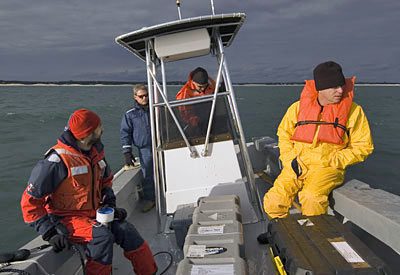
As we follow the REMUS, the clouds turn a shade more menacing. Dawson keeps checking his gas gauge and his watch, which makes me nervous. Once the clouds start spitting their first raindrops, we send the abort command. We grab the REMUS and beat back to safety with water sheeting over the rails and a storm kicking up all around us.
I’m soaked to the skin when we pull back in to Eastham, but overall, it was a great start to this winter’s work—a nice late fall data section at a fraction of the cost of a day aboard the research vessel Oceanus. And, we’re back at WHOI in time to make the afternoon seminar.
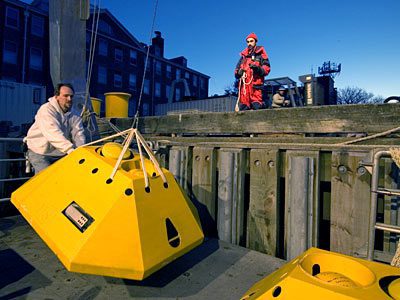
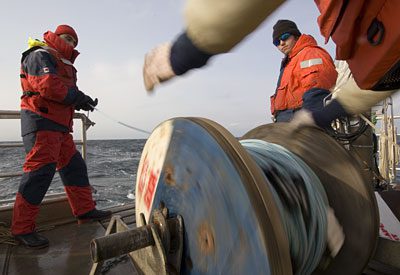
I do most of the work on my knees so that I can better maintain my balance. By 3 p.m., the sun is sinking low on the horizon. All of the moorings—six lightweight temperature logger strings and two bottom-mounted instrument cages—are safely at sea with no mishaps; a very good day.
Everyone keeps asking where I got my tan. I think it’s actually windburn.
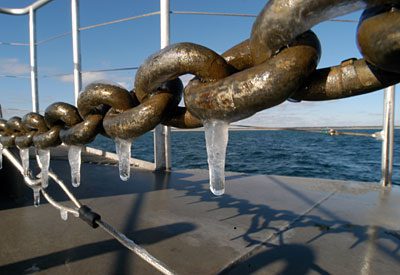
The REMUS collects data while we hunker down out of the wind behind the pilot house. The sun is back down before we hit the pier. We’re the science vampires—leaving in the dark, returning in the dark, carrying a heavy coffin full of data sucked from the sea.

Finding a weather window for our work has been a challenge. We watch the forecast, trying to guess how it will change before we arrive at the pier. Waiting for acceptable conditions—winds at or below 15 knots and seas under 6 feet—has been frustrating. After a hurried meeting, Glen makes the call: “Marginal is better than nothing, let’s go for it.” On this particular January day, the light aluminum Tiogabobs corklike on the northeasterly swell.
I can see the exhaustion written on everyone’s faces. We deploy the REMUS and turn on the acoustic tracking. Our routine is now familiar: We take turns lowering the small fishlike tracking device into the water, then we wait for the vehicle to send us its status. After confirming the vehicle is on track, we pull the “fish” back onboard and head off to the next location.
We’re battered and bruised from trying (unsuccessfully) to keep our footing on the pitching deck. The seasickness medication makes me a walking zombie. By midday, we’re all catnapping on the transits, lulled by the throbbing bass of Tioga’s engines. Rainbows—probably the last thing I’d expect to see on a day like this—form in the white water flying over the rail.

The previous winter two entire mooring chains were mysteriously lost, so it is a relief when we find that all six of the temperature moorings are right where we left them three months ago. Only two moorings, the bottom-mounted cages, remain.
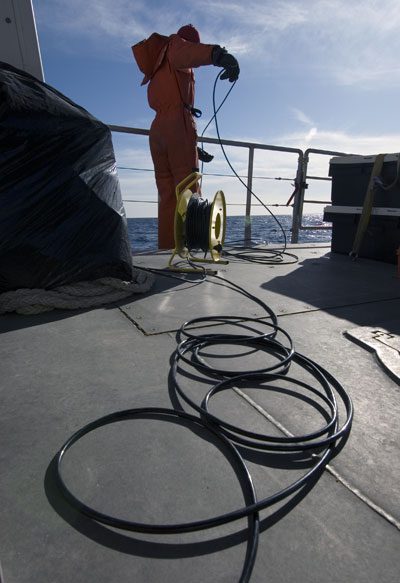
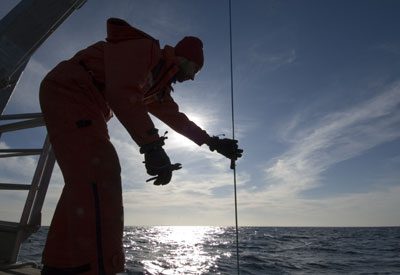
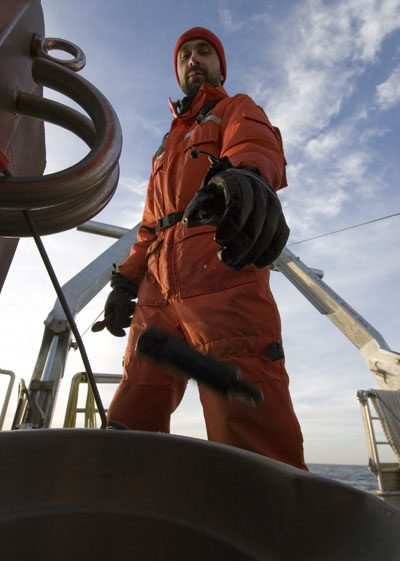
March 24, 2006—Andrey is on the phone with Greg Packard, REMUS expert from the WHOI Applied Ocean Physics and Engineering Department, getting some technical advice at sea. Glen (center) and Jen Hua Tai, a visiting student from Taiwan (blue jacket) watch expectantly to see if data from a sidescan sonar will reveal the location of the missing ADCP mooring. “Wave ripples, sandy bottom,” Andrey declares as he scans the images. Of the lost mooring, there isn’t a trace.
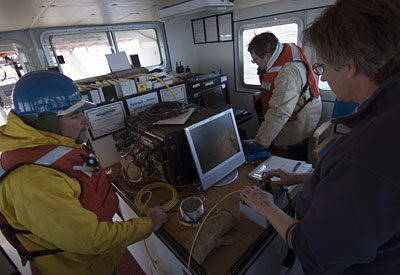
“This current is too strong to anchor. I’ll have to keep her in position using the engines,” Captain Ken Houtler explains. After a full day of searching, we give up on the missing mooring. It’s possible that a scallop trawler snagged it and dragged it far out to sea.
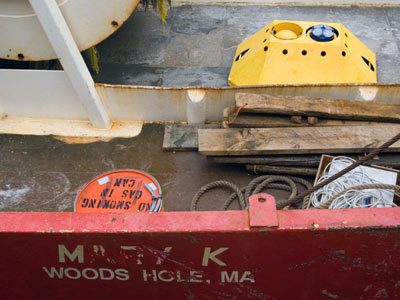
Related Articles
Featured Researchers
See Also
- REMUS (Remote Environmental Monitoring UnitS) from the WHOI Ocean Instruments Web site
- Glen Gawarkiewicz's Homepage
- The Woods Hole Sea Grant Program
